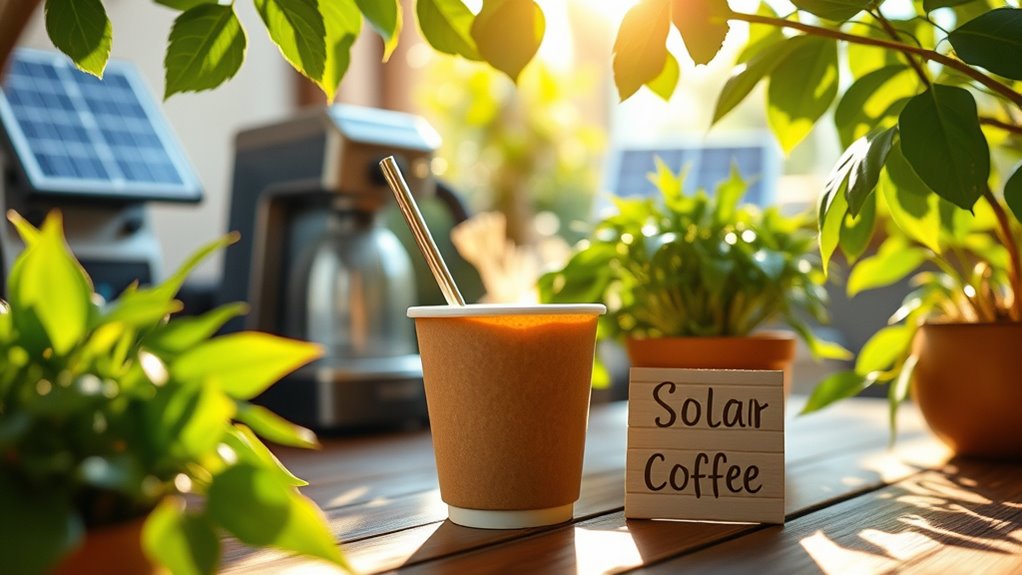To reduce your carbon footprint with sustainable coffee, choose options like shade-grown, organic, or certified brands that support eco-friendly farming and protect forests. Opt for brewing methods that avoid waste, such as French press or AeroPress, and use reusable cups. Supporting local roasters and shorter supply chains also lowers transportation emissions. Switching to plant-based milk and composting coffee grounds further cuts your impact. Keep exploring for more ways to enjoy coffee sustainably and make a difference.
Key Takeaways
- Choose shade-grown, organic, or certified sustainable coffee to support land preservation and reduce deforestation-related emissions.
- Opt for plant-based milk, energy-efficient brewing methods, and reusable cups to lower household and waste-related carbon footprints.
- Support local sourcing and bulk shipping to cut transportation emissions and reduce supply chain impacts.
- Use eco-friendly processing options like solar dryers and methane capture systems to minimize emissions during production.
- Stay informed about industry certifications and transparent brands that prioritize sustainable practices and responsible sourcing.

Sustainable coffee practices are essential to reducing the industry’s carbon footprint, as most emissions—up to 91%—occur before the coffee even reaches your cup. When you consider that cultivation, processing, and transportation generate the majority of emissions, your choices as a consumer can considerably impact the environment.
By opting for coffee that’s produced with sustainability in mind, you help lower these pre-farmgate emissions, which include land-use change, fertilizer use, and processing methods.
Land-use change is a major contributor to coffee’s carbon footprint, with emissions ranging from 3 to over 40 kilograms of CO₂e per kilogram of roasted coffee. When farmers clear forests to expand coffee plantations, they release stored carbon into the atmosphere, accelerating climate change. Choosing shade-grown coffee can help mitigate this effect. Shade-grown coffee supports forest preservation, sequesters carbon, and maintains biodiversity. Organic fertilizers further reduce nitrous oxide emissions compared to synthetic options, making farm practices more climate-friendly.
Agroforestry systems, which integrate trees with coffee crops, enhance carbon storage and improve soil health, creating a more resilient farm environment. Efficient irrigation minimizes water use and reduces the energy needed for pumping and processing, while intercropping diversifies income streams and strengthens soil quality, reducing the need for chemical inputs.
Processing and transportation are also key stages where emissions accumulate. Using solar-powered dryers instead of fossil-fuel-dependent machines can cut energy consumption during drying. Wet mills equipped with methane capture systems significantly reduce wastewater emissions, preventing greenhouse gases from escaping into the atmosphere.
Optimizing bulk shipping and choosing localized roasting hubs shorten supply chains, decreasing transportation emissions per unit. Reusable packaging like GrainPro bags during transit minimizes waste and reduces the environmental impact of packaging materials.
As a consumer, your choices can lead to substantial reductions in your coffee’s carbon footprint. Replacing dairy milk with plant-based alternatives for your lattes can cut emissions by up to 60%. Brewing coffee with methods like French press or AeroPress avoids single-use pods, which generate billions of landfill-bound cups annually.
Using energy-efficient appliances, such as induction stoves, further lowers your household’s energy use. Composting coffee grounds prevents methane emissions from landfills, and bringing your own reusable cup eliminates waste from disposable containers.
Supporting certifications such as Rainforest Alliance, Fair Trade Organic, or Bird-Friendly® ensures your coffee is produced with environmentally responsible and socially equitable practices. These standards promote deforestation-free sourcing, biodiversity, and fair income for farmers.
Many companies are investing in renewable energy, circular packaging, and transparency programs that track emissions from farm to cup, giving you confidence in your choices. Additionally, increasing awareness about self-understanding can inspire more mindful and environmentally conscious consumption habits.
Frequently Asked Questions
How Can I Verify if My Coffee Is Truly Sustainably Sourced?
To verify if your coffee is truly sustainably sourced, start by checking for industry-standard certifications like Fair Trade, Rainforest Alliance, or USDA Organic.
Look for Starbucks C.A.F.E. Practices or Smithsonian Bird-Friendly labels.
Review the brand’s transparency reports and traceability maps to see the journey from farm to cup.
Additionally, research their supply chain practices, third-party audits, and commitments to environmental and social standards to guarantee genuine sustainability.
Do Eco-Friendly Coffee Brands Cost More Than Conventional Options?
Think of eco-friendly coffee brands as rare gemstones—more vibrant but often pricier. Yes, they typically cost more than conventional options, thanks to organic certifications, regenerative farming, and quality testing that add layers of expense.
While you might pay a premium upfront, you’re investing in better health, fairer wages, and a healthier planet. So, your wallet might feel a pinch, but your conscience stays clear and your mornings richer.
What Are the Best Reusable Accessories for Reducing Waste?
You can substantially cut waste by choosing reusable accessories like metal or silicone straws, cloth coffee filters, and reusable coffee cups or pods.
These items are durable, easy to clean, and made from sustainable materials, making them ideal for reducing single-use plastics and packaging.
How Does Coffee Transportation Impact Its Overall Carbon Footprint?
You might wonder how coffee transportation impacts its overall carbon footprint. It accounts for about 15% of total emissions, mainly from cargo ships.
With air transport increasing carbon output by 70%. Long-distance shipping from production to your cup means fuel use and emissions are significant.
Choosing sustainable transportation methods, like sea freight over air, and supporting efficient logistics can help reduce this environmental impact.
Can Home Brewing Methods Lower My Coffee-Related Emissions?
Did you know that manual brewing methods like pour-over or French press use up to 80% less energy than automatic machines? By choosing these options, you actively lower your coffee-related emissions.
Additionally, brewing full batches, controlling water temperature, and maintaining equipment boost efficiency.
Reusable filters and cold brewing further cut waste and energy use. Your small changes can make a big difference in reducing your overall carbon footprint.
Conclusion
By choosing sustainable coffee, you hold the power to turn the tide on climate change. Every cup you sip can be a seed of change, nurturing a healthier planet for future generations. Remember, your actions ripple outward—like a stone cast into a pond—creating waves of impact. So, make mindful choices today; your small steps can lead to a giant leap toward a greener, more sustainable world.









